Munich Is More Than Beer and BMWs — Here's How to See a New Side of the City
With sleek new hotels, tech spaces, and high-concept museums, Munich has become the European Silicon Valley.
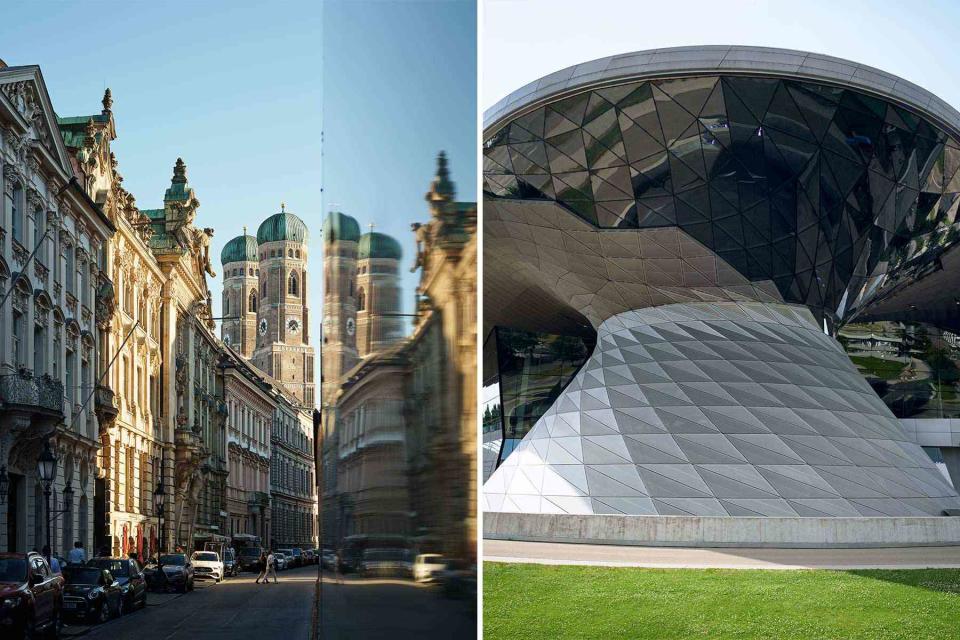
Christian Kane
From left: The Frauenkirche, in the heart of Munich’s Old Town; the BMW Welt exhibition and event space.The low skyline of Munich is dominated by the 323-foot-high, copper-topped spires of the old Frauenkirche cathedral, which by tradition are meant to remain the tallest things in town. Looking up from the street, however, the things you first notice are construction cranes. They are everywhere. Munich is a medieval city; its official founding day is June 14, 1158. But Munich is refounding itself all over again, and fast. Even if you’ve been this way before (say, for a sudsy Oktoberfest), you’ll pass through quite a different place when you return.
Few cities are as burdened by visual clichés as Munich. Once seen, the jovial chap in leather shorts with a silly feather in his silly hat is impossible to unsee. He’s still around, bless him, hoisting his silo-size beer stein. Munich holds tight to its Bavarian traditions. But today’s Münchner is just as likely to be a skinny young coder in a hoodie who has moved to this town to become a part of the frenetic start-up scene.
Munich holds tight to its Bavarian traditions. But today’s Münchner is just as likely to be a skinny young coder in a hoodie who has moved to this town to become a part of the frenetic start-up scene.
Twenty years ago, “laptops and lederhosen” was a vague political promise. Now it’s a brand. The annual Bits and Pretzels start-up conference began in 2013 with a breakfast for 80 people. In 2017, it had to cap attendance at 5,000. In 2019, President Obama showed up. Apple has made Munich its biggest European engineering hub. Last year, it pumped $1.2 billion into a new building on Karlstrasse. These are just two among many examples of how the future is taking root in Munich’s beer-soaked soil.
As a music lover in a land of them, my first look at Munich’s breakneck urban renewal had to be the new Gasteig auditorium and cultural complex, which had opened just a week before my visit last October. It was built as a temporary home for the Munich Philharmonic Orchestra, whose old red-brick headquarters are to get their own top-to-bottom makeover.
Gasteig HP8, as the complex is known, has commandeered the transformer room of an old power station for its entrance hall and library. (Any passerby can grab a book or a music score off the shelves. “We just hope you bring it back,” said Kathrin Metzner, who works in marketing for the new Gasteig.) It’s on an outer ring road, making it a little tricky to get to, but then much of the new Munich is spreading outward. The designers left the old concrete floors and air ducts exposed. This kind of industrial look has become something of a design cliché, though it can be done well or badly. Here it is done very well.
Related: Berlin Travel Guide
The blue-collar aesthetic goes hand in hand with the new Gasteig’s spirit, which treats high culture as an ordinary neighbor. It shares its premises with a Pilates studio, a Reifenhandel, which is German for a tire-changing garage, and several other commercial tenants. “They were all frightened we were going to throw them out, but we didn’t want to say, ‘Culture is coming, you have to leave,’” Metzner said. “We’re not some kind of UFO flying in.” When I walked through, the Reifenhandler was plying his trade, and I was told that he was even considering some kind of radials-and-Rachmaninoff package deal.
The glory of the Gasteig is the music hall itself, which was built from scratch in wood and sheathed in steel. Most of the development’s modest budget went into the hall’s sound, which was entrusted to the acoustical maestro Yasuhisa Toyota (he has nothing to do with cars), who also did the Walt Disney Concert Hall in Los Angeles. I wandered in during a dress rehearsal. The conductor and various musicians kept getting up to roam among the seats; they were giving the new hall a final test-drive before its first visitors arrived. I was lucky enough to get a last-minute ticket for that evening’s performance. The piece was the chest-thumping "A Hero’s Life" by Munich’s own Richard Strauss, and every note remained crystal-clear despite the thundering volume.
The walk back to the center of town was long, but happily, much of the way lies along the banks of the Isar River, which starts high in the Alps and rushes down through the city. In 2000, Munich set about restoring the Isar: concrete was removed and riverbanks were leveled; gravel beaches appeared on islands beside bathing pools; water quality was improved. Fish and fowl long absent have returned to share the river with Munich’s summer skinny-dippers. The “Isar-Plan” took 11 years to complete, but it has left an idyllic woodland at the city’s core. My stroll from the Gasteig felt more like a hike in the country.
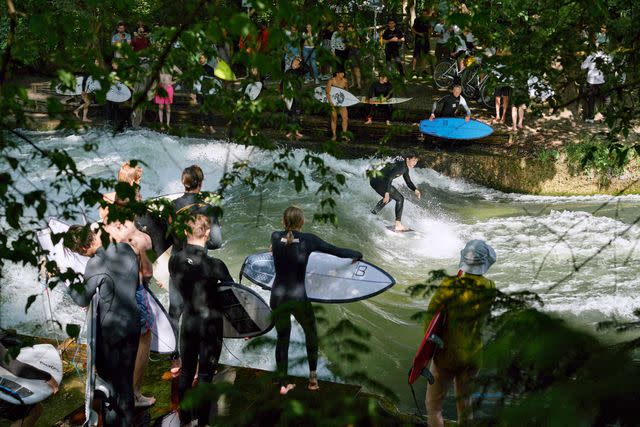
Christian Kane
Surfers wait to drop in at the Eisbach.The river also generates Munich’s most unlikely pastime: surfing. In the 1970s, the city fathers sank concrete blocks under a bridge over the Eisbach — a tributary of the Isar whose name means “ice brook” — to slow down the river’s fierce current. A powerful standing wave formed on the spot, and overnight, local surfers started showing up to frolic in the frigid waters. Eisbach surfing remained technically illegal until 2010, but when I walked past, spectators were lining the banks to watch some two dozen hardy surfers in wet suits ride the liquid roller coaster. It has become an unmissable Munich attraction.
If Munich’s pleasure-loving burgher were a hotel, he would be the grand old Bayerischer Hof, which holds down an entire side of the Promenadeplatz. It sprang from the mind of King Ludwig I, who mentioned one day in 1839 that he wouldn’t mind a first-class hotel in Munich, and so, of course, he got one. The Volkhardt family has owned and run it since 1897, with the fourth generation’s Innegrit Volkhardt now at the helm.
More Travel Ideas: 12 Best Small Towns in Germany, From Charming Medieval Villages to Idyllic Mountain Escapes
The hotel has expanded over the years into a sprawling warren of 337 rooms, 74 suites, 40 function rooms, and five restaurants. The service is impeccable, as behooves an institution that has had to please both Sigmund Freud and Michael Jackson (across the street, the statue of Renaissance composer Orlando di Lasso has been repurposed as an ad hoc shrine to Jackson since his death). And it is very German. I had a mind to see the latest James Bond movie in the hotel’s plush theater, but they were only showing it as "Keine Zeit zu Sterben"; not enough English speakers in the hotel to show "No Time to Die," I was told.
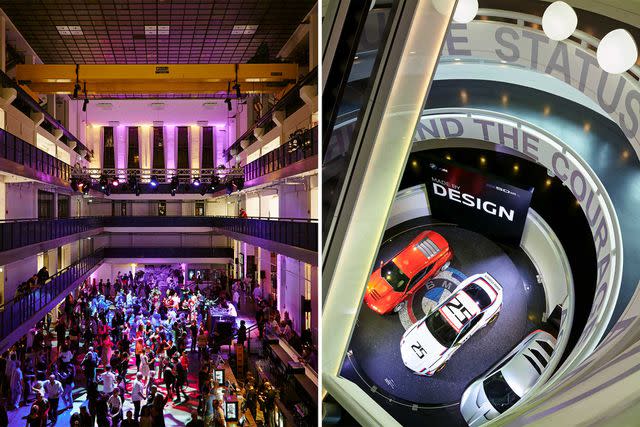
Christian Kane
From left: Salsa night at the Gasteig HP8 cultural center; the BMW Museum.Even this stolid bastion of Munich high society is feeling the winds of change. For the past six years, the Belgian design guru Axel Vervoordt has been making his way through the hallways, breathing fresh air into a wing of rooms here, a restaurant there, and, most recently, an entire annex of conference rooms. Vervoordt’s instinctive minimalism and taste for rustic wood and rudimentary shapes has cut away much of the hotel’s baroque bloat and given it a modern feel. Some of the staff members have taken to calling it the Flemischer Hof, a nod to Vervoordt’s Flemish roots. They mean that in a good way.
It’s a short walk from Hotel Bayerischer Hof down to an island in the Isar where the Deutsches Museum rides at anchor like a mothballed dreadnought — which in a sense is what it is, or was. Since it opened in 1925, it has grown to become the world’s largest science and technology museum, with 270,000 square feet of biplanes and submarines, telescopes and microchips (it was the first museum to get a quantum processor in 2019, courtesy of Google’s Munich operation) and hundreds of wonderful, insanely detailed dioramas (the museum employs 100 people just to make them).
At Munich Motorworld, across town, a cluster of private dealers sell some of the world’s fastest, most coveted, and most fanciful automobiles. The floor is surrounded by 112 glass boxes with a sexy car in each one.
The Wright Brothers plane hanging from the ceiling is the one they left behind in 1909, after failing to sell their designs in Germany. The World War I U-boat is the only one left: the rest of Germany’s fleet was destroyed under the Treaty of Versailles, but Oskar von Miller, the museum’s beloved founder, petitioned the Allies to let him keep one as an exhibit.
For all that, the museum building had slid into musty decrepitude, a vast holding pen for easily distracted children on school outings. This would not do. In 2015, the museum shut down half of its exhibits (not that you’d notice) to undertake a thoroughgoing refurbishment. I arrived after the renovated half reopened and just before the other half closed down until 2025. Everything sparkles, down to the tiny sheaves of wheat under the miniature millstone in a diorama of ancient agriculture. The museum gets 1.5 million visitors a year, but I was told only a tiny fraction of them come from overseas. What a shame.
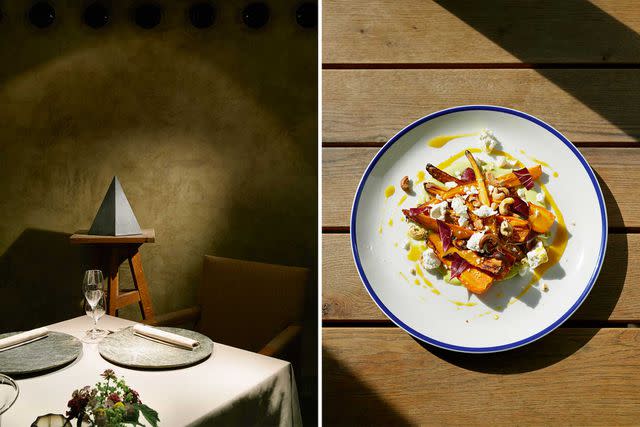
Christian Kane
From left: Hotel Bayerischer Hof’s restaurant, Atelier; carrot salad at Spezlwirtschaft Haidhausen.
A few steps east of the museum lies the Haidhausen neighborhood, which spent almost a thousand years in Munich’s shadow before being folded into the city proper in the mid 1800s. The people who lived there dug loam from the banks of the Isar to make the bricks for the Frauenkirche.
Poor devils. For centuries, Haidhausen was Munich’s skid row — the German word is glasserbenviertel, a neighborhood of broken glass. Houses were cramped and insalubrious, and many residents lived hard, short lives. There’s no broken glass around today. The city started rebuilding Haidhausen in the 1980s, and it has since become one of Munich’s most stylish neighborhoods. A small house, if you can find one, might sell for millions and look like a country cottage with flowers on the windowsills.
Related: 12 Beautiful German Castles That Look Like They're Straight Out of A Fairytale
The local restaurant scene is lively, too. I stopped into a place called Spezlwirtschaft Haidhausen, on Pariser Strasse (it means Paris Street, and it’s one of a number of French street names in Haidhausen’s so-called French Quarter). Spezlwirtschaft serves what has come to be called “nouveau Bavarian cuisine,” but don’t be misled. This is not Munich’s equivalent of France’s nouvelle cuisine, with its lighter ingredients, smaller portions, and overall spirit of deprivation. New Bavarian cuisine favors fresh local produce — and is usually served in rooms with funky décor — but retains the no-holds-barred pleasure principle Munich lives by.
Exhibit A is the potato soup, normally a harmless Bavarian staple, which Spezlwirtschaft loads with truffles and who knows what else to become a lethal flavor cannon. It’s on the menu as a starter but it should have been a finisher. There was no need to keep on eating after that.
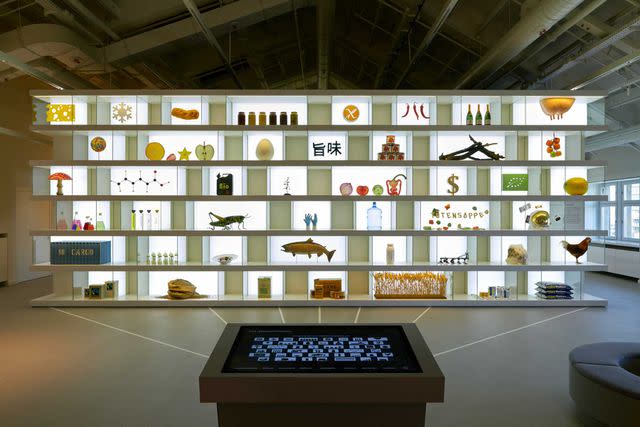
Christian Kane
“The Grocery Shelf,” an exhibit at the Deutsches Museum.
The real power of the potato in Munich can be felt in an industrial zone across the railroad tracks from Haidhausen. It’s where the Eckart family built their fortune after World War II by turning kilotons of potatoes into Pfanni-brand mashed-potato flakes.
The Eckarts don’t make Pfanni flakes there anymore, but they still own all the land, which they’re transforming into Munich’s newest frontier. Werksviertel-Mitte is the name of the Eckarts’ enlightened urban experiment. It’s a delightful amalgam of start-up incubators, global food stalls, affordable apartments (sorely needed in Munich), performance spaces, artist’s studios, boutique hotels, and a kitchen sink of anything else needed in the groovy urban utopia of tomorrow. A plan was also recently approved to build a new auditorium complex. It will one day be the home of the Bavarian Radio Symphony Orchestra.
The walk back to the center of town was long, but happily, much of the way lies along the banks of the Isar River, which starts high in the Alps and rushes down through the city. In 2000, Munich set about restoring the Isar. The “Isar-Plan” took 11 years to complete, but it has left an idyllic woodland at the city’s core. My stroll from the Gasteig felt more like a hike in the country.
I checked in to Werksviertel’s new Adina hotel, which occupies 16 floors of a 24-story tower over what had been a huge silo for potato flour (yes, it breaks the Frauenkirchen height rule, but it’s far away, and besides, it offers some of the best views in Munich).
The Adina is an apartment hotel, meant for both shorter and longer stays (all those migrant techies need someplace to sleep). My studio looked directly onto the roof of Werk3, the quarter’s flagship. There, just beyond my window, a flock of fluffy sheep was grazing contentedly outside a wood Tyrolean cabin. That’s Werksviertel for you. “In ten years, this will be the benchmark for how you want to live,” Daniel Wiechmann told me. Wiechmann works for the Eckart Foundation, so he would say that, but that doesn’t mean he’s wrong, either.
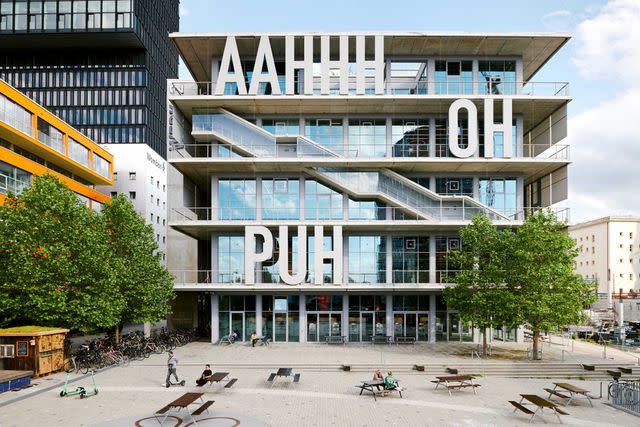
Christian Kane
Werk12, a mixed-use development in Werksviertel-Mitte.Bavarian Motor Works, also known as BMW, calls Munich home, and it wants to make sure everybody knows it. The BMW logo on the roof is 130 feet in diameter and plainly visible in satellite images on Google Earth. Many well-known brands like to celebrate themselves in steel and concrete, but the futuristic BMW campus just beside Munich’s Olympic Park is hard to beat for shameless self-glorification. It’s also a blast, even if, like me, you were never really bitten by the car bug.
The bowl-shaped BMW Museum, completely renovated in 2008, is a kind of automotive Guggenheim, with ramps spiraling down through the model years. Across the street, BMW Welt, or BMW World, is where you ogle current models and either buy one or just drool quietly. It’s basically a big car dealership, but it’s the dealership for Mount Olympus (ask yourself how many others have a restaurant with two Michelin stars).
At Munich Motorworld, across town, a cluster of private dealers sell some of the world’s fastest, most coveted, and most fanciful automobiles. The floor is surrounded by 112 glass boxes with a sexy car in each one. At an Ameron hotel that is literally attached to Motorworld, three of the hotel’s studios allow guests to park their cars right next to their rooms and keep them in view through a pane of glass. I was content to leave my little Mazda (which I happen to like a lot!) in the garage. Instead, I gazed longingly onto a bright red Mustang and the cobalt-blue Nissan that starred in the Fast and Furious movies.
When you hit the button for your floor in the hotel elevator, you hear the vroom-vroom of a car engine revving. Whether you find that dumb or kinda cool depends on how you look at it. Me, I went with kinda cool.
Where to Stay
Adina Apartment Hotel Munich: Housed in a 24-story skyscraper in the Werksviertel-Mitte development, this property has apartment-style studios ideal for longer stays.
Ameron München Motorworld: Don’t want to be separated from your car? In addition to traditional rooms, this hotel has three studios fitted with glass booths that shelter guest vehicles.
Hotel Bayerischer Hof: This grande dame in the city center opened in 1841, but its modern-day improvements include designs by Axel Vervoordt and a movie theater.
Where to Eat
Spezlwirtschaft Haidhausen: Nouveau Bavarian dining in Munich’s French Quarter, with dishes like crispy roast pork and potato dumplings served with a dark-beer sauce.
What to Do
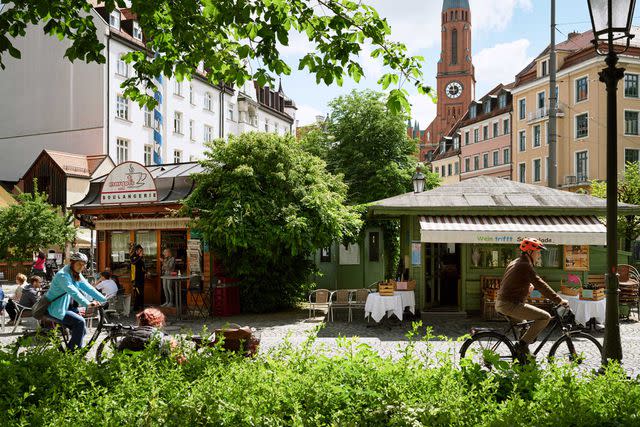
Christian Kane
The Wiener Platz Market, in the Haidhausen neighborhood.BMW Welt: This futuristic automobile showroom encompasses the BMW Museum and a Michelin two-starred restaurant, EssZimmer.
Deutsches Museum: The world’s largest technology museum spans all manner of sciences, from atomic physics to aeronautics, with plenty of hands-on exhibits for kids.
Gasteig HP8: With its exemplary acoustics, this performing-arts auditorium and cultural center is the place to go for chamber music and the philharmonic.
Munich Motorworld: Top specimens of the world’s most coveted car brands, from million-dollar Singer Porches to the latest Maseratis, inside a massive steel hall.
Werksviertel-Mitte: Once an industrial neighborhood filled with neglected discos and arcades, this development has hip apartments, shops, and food stalls.
A version of this story first appeared in the October 2022 issue of Travel + Leisure under the headline "Future Perfect."
For more Travel & Leisure news, make sure to sign up for our newsletter!
Read the original article on Travel & Leisure.

